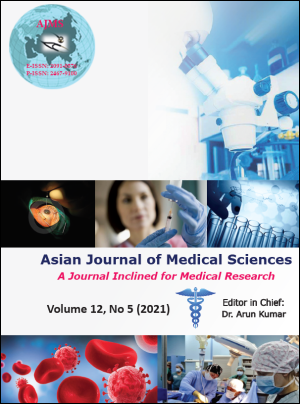Morbidity and mortality profile of children admitted in pediatric department – A single center study
Keywords:
Morbidity, Mortality, Vaccination, Under nutrition, Infection, OutcomeAbstract
Back ground: Child morbidity and mortality is an issue of great concern for policy makers because in spite of good efforts still less than 5 years mortality rate is very high and many babies could not survive beyond infancy. Majority of pediatric deaths occurred due to preventable and treatable causes. An emphasis needed on early diagnosis and timely interventions in pediatric patients associated with high risk factors.
Aims and Objectives: To study clinical spectrum, morbidity and mortality profile in hospitalized children and to evaluate association of clinicodemographic variable with outcome.
Materials and Methods: A cross sectional study was conducted among 2315 patients admitted during study period to evaluate morbidity and mortality profile of patients in pediatric department. Data was collected between January to December 2018 and analyzed for demography, clinical profile including diagnosis, hospital and pediatric intensive care stay, management and outcome.
Results: Mean age (mean ± SD) reported was 42.35 ± 35.85 months. Under 5 years children were admitted in majority (62.5%). Respiratory system (21.9%) and nervous system diseases (21.7%) were leading reasons for admission followed by gastrointestinal (11.2%) and hematological disorders (10.8%). Based on etiology infection was leading cause, most common infection in hospitalized children lower respiratory tract infections (19.5%). Vaccine preventable diseases were present in 3.7% patients. 2.5% children admitted due to severe acute malnutrition (SAM). Nervous system diseases (18.2%) associated with highest mortality followed by cardiac (11.7%) and respiratory diseases (11.2%) Mortality rate was 8.07%. Significant association was found between gender, duration of PICU stay, condition at admission, under nutrition and severe anemia to outcome (p <0.01).
Conclusion: Early diagnosis and timely interventions can improve outcome in patients with co morbidities and high risk factors. Social awareness is very important to prevent gender discrimination. Emphasis on simple hygiene measures, vaccination and nutrition improvement can decrease the disease burden in pediatric population. Vaccine preventable diseases still occurring and needed hospitalization so strengthening of awareness program for vaccination required, especially in remote rural areas.
Downloads
Downloads
Published
How to Cite
Issue
Section
License
Authors who publish with this journal agree to the following terms:
- The journal holds copyright and publishes the work under a Creative Commons CC-BY-NC license that permits use, distribution and reprduction in any medium, provided the original work is properly cited and is not used for commercial purposes. The journal should be recognised as the original publisher of this work.
- Authors are able to enter into separate, additional contractual arrangements for the non-exclusive distribution of the journal's published version of the work (e.g., post it to an institutional repository or publish it in a book), with an acknowledgement of its initial publication in this journal.
- Authors are permitted and encouraged to post their work online (e.g., in institutional repositories or on their website) prior to and during the submission process, as it can lead to productive exchanges, as well as earlier and greater citation of published work (See The Effect of Open Access).




